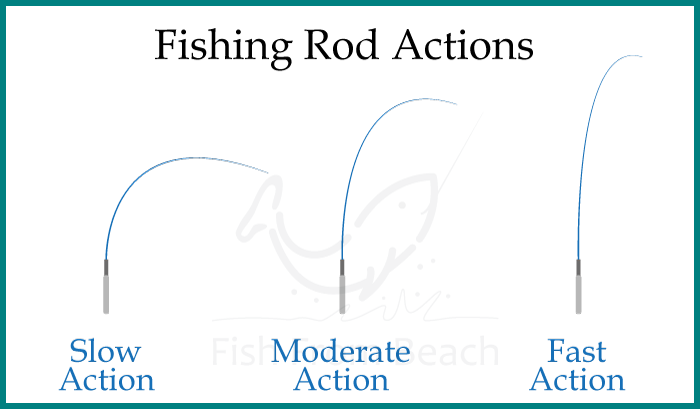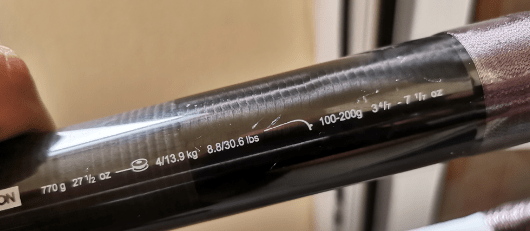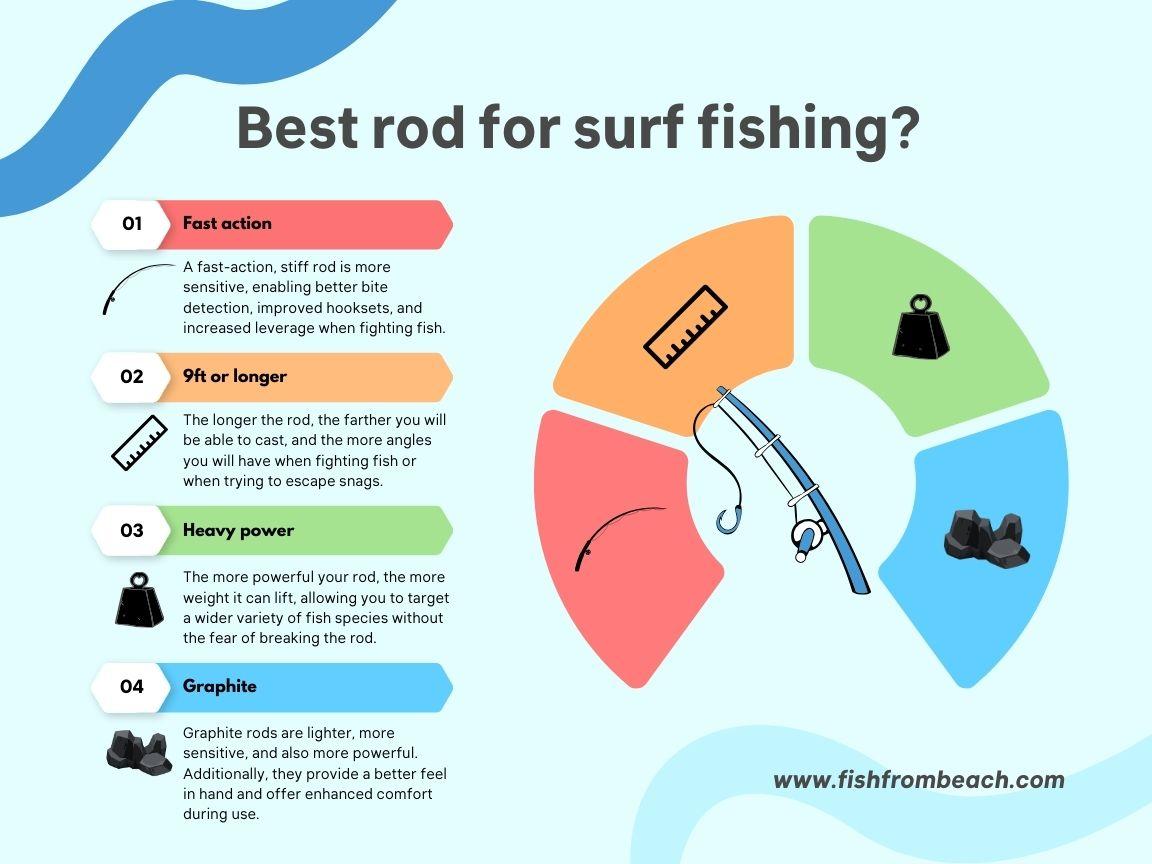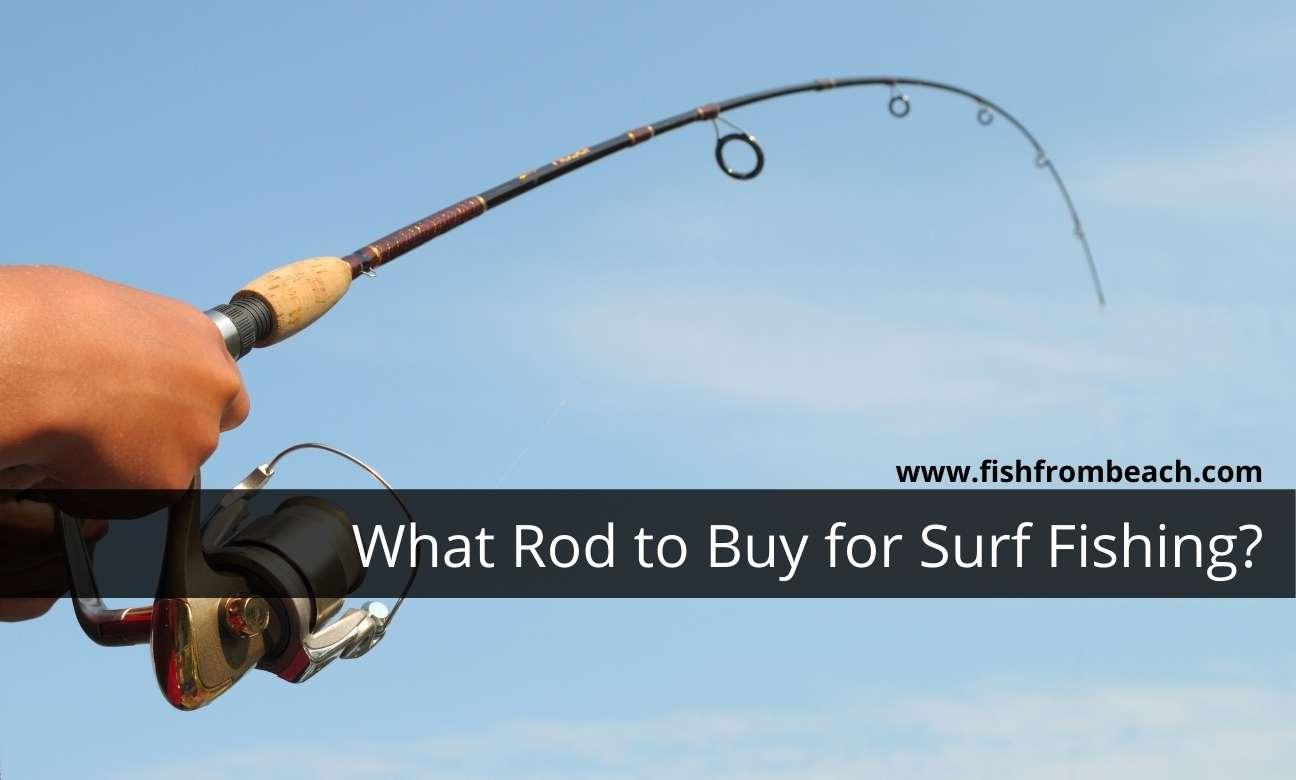Choosing the best rod for surf fishing is not an easy task.
With a bunch of variables and factors to consider, there are a lot of ways to buy a rod that isn’t right for your fishing conditions and objectives.
That’s why I decided to write this article.
I wanted to share with you everything I know about surf rods and the different factors to consider the next time you decide to buy a new pole.
So without further ado, let’s dive in.
The takeaway
The best rod for surf fishing is:
- 9ft or taller, but not too tall that it becomes uncomfortable to handle
- Has a moderate or fast action (stiffness)
- Has a medium-heavy or extra-heavy power (lifting power)
- Made of graphite material or composite
Let’s now go in more depth and discuss all the variables and factors.
The length of a surf rod?
Rods longer than 9ft are generally the most suitable for surf fishing.
The thing to remember here is that the longer the rod, the farther you can cast, and as a result, the more spots you can try in the surf.
This gives you more options in terms of where to deploy your bait, hence improving your chances of finding a winning spot.
In other words, rods longer than 9ft provide more angles and baiting options and allow testing other zones when the nearby areas bring poor results.
Having said that, it’s worth noting that you shouldn’t always go for the longest pole you find in the tackle store.
You still need to check if the rod feels good in your hands and that you can easily maneuver it. The thing to remember here is that the bigger the rod, the more fatigue it will cause to your shoulders and arms after a long day of fishing.
So make sure the rod is suitable for your height and morphology and that you can maneuver it for a long time without issues.
Personally, most of my surf rods are within the 10-12 ft range. I’m 5’8 and this is what I find compatible with my height.
My fishing friends who are 6ft tall are comfortable with 12-13ft rods.
So it’s very important to find your comfort range and stick to it. Your tackle provider can be helpful here and recommend some good rods based on your body.
So don’t hesitate to ask.
We discussed the question of length in more depth in this article. I invite you to give it a look for a complete understanding of this topic.
The best rod action for surf fishing
What does rod action mean?
The action (also called the speed) of a fishing rod describes the point at which the rod bends when exposed to pressure.
Generally speaking, there are 3 classes of action:
- Slow action rods (also called slow rods) are rods that bend starting from their lower 1/4 part.
- Moderate action rods are rods that bend starting from their half.
- Fast action rods (also called fast rods) are rods that remain stiff under pressure and only flex their higher tip.

Nowadays, manufacturers produce other degrees of action and during your next visit to the tackle store, you may find expressions like slow to moderate action, moderate to fast action, extra-fast action, etc.
Don’t be overwhelmed by these statements. They are simply slight variations of the standard classification: slow, moderate, and fast.
How stiff should your surf rod be?
Fast action (stiff) rods are more sensitive and transmit energy faster and more accurately.
This means that when the rod is fast, no matter what movement you make with it, it will transmit most of your energy and intentions efficiently and give you the results you want to achieve.
This puts you in a better position during fights and provides you with more authority to secure your catches.
Bite detection is also easier with fast action rods.
Strong winds and waves don’t bend stiff rods like they do with slower rods.
Therefore, when a fish takes your bait and starts pulling on the line, you will be more confident to say it’s a bite and not just the wave/wind effect.
Fast rods also transmit the subtle vibrations that small fish create when they tug on baits, giving you a clear signal that it’s time to collect the line.
Now, with this in mind, I believe novice anglers should avoid extremely fast (stiff) rods.
If you haven’t yet acquired the skill of gauging the appropriate amount of pressure to exert on the rod, whether during a hookset or when fighting a fish, using fast action rods can be punishing if you accidentally apply more force than necessary.
The feeling of the right pressure to apply is a skill that you only gain after years of experience and lots of trial and error. Until then, be prepared to lose many catches due to exerting too much stress during fights.
To minimize such accidents, it’s recommended to avoid excessively fast rods.
Something rated “medium-fast” or “moderate-fast” is usually the best way to go on your first trips.
Such rods combine the stiffness and high sensitivity of fast action rods with the flexibility and tolerance of slow rods. This way, you will have a pole that turns fish effectively, while also offering you a margin of error where you can make some mistakes without facing severe consequences.
So to summarize, for experienced anglers, fast action rods are the best for surf fishing. For beginners, I recommend rods that are within the moderate to fast action range.
Do not confuse action with power
When it comes to rods, beginners often confuse action with power, although they are two different things.
As we said, action only describes how the rod bends under pressure. It says nothing about the lifting power of the rod and how much stress it can take.
In other words, action only defines the stiffness of the rod and at which point it starts to flex when we pull on the tip.
Power, on the other hand, is what defines the strength of the rod and how much weight it can lift regardless of the way it bends under pressure.
Put another way, power tells how much pressure we need in order to bend the rod while action describes how the rod bends once we apply that amount of pressure.
So a fast action rod doesn’t necessarily have a high lifting power.
Yes, fast rods are stiff and don’t bend much, but exposing them to a lot of pressure can break them.
Likewise, a heavy power rod is not necessarily fast and stiff. It simply requires more weight to bend. Once you achieve that weight, it will either bend completely (if it’s slow) or only flex the higher section (if it’s fast).
Having said that, it’s worth noting that heavy power kind of compensates for slow action.
Meaning, if a rod is powerful and requires a lot of stress to bend, it will remain stiff and react as a fast rod most of the time. It won’t show its low-action characteristics until things get really heavy.
In general, you will be able to know the power of a fishing rod by reading the information on the rod itself, in the manual, or by browsing the manufacturer’s website.
So this shouldn’t be a hard task.
But again, make sure you don’t confuse power with action.
Some manufacturers use ambiguous vocabulary when rating their rods, which can be quite misleading.
It is therefore very important to read thoroughly all the available information before making any decision.
When in doubt, there is another way to know how powerful a fishing rod is, and that is by checking the recommended line strength (pound test) stated on the rod.

Rod manufacturers want you to use a line that is weaker than the rod, so that when things get heavy, the line breaks before the rod.
For instance, in the image above, my rod manufacturer advises using a line that can withstand between 8.8 and 30 pounds (or between 4 and 13.9 kilos) of weight.
So this gives a good idea of the strength of the rod and how much pressure it can withstand before breaking.
The table below provides general guidelines on how to interpret such information to guess a rod’s power.
| Rod Power | Line Size |
|---|---|
| UL – Ultra Light | 1 - 4 lb test |
| L – Light | 4 - 10 lb test |
| ML – Medium Light | 6 - 12 lb test |
| M – Medium | 10 - 16 lb test |
| MH – Medium Heavy | 14 - 26 lb test |
| H – Heavy | 20 - 40 lb test |
| UH – Extra Heavy | 30+ lb test |
As you can see, heavy-power rods can be paired with strong lines. Light-power rods, on the flip side, are easy to break and therefore require weaker lines to keep them safe.
As a rule of thumb, surf rods should range between medium heavy and extra heavy power. This range provides the necessary lifting power to handle most fish in the surf, while also possessing the strength and backbone to tackle the sizable monsters that show up occasionally.
Graphite, fiberglass, or composite rods?
The material of your rod is another factor to consider.
There are generally 3 options here: graphite, fiberglass, and composite.
Graphite rods tend to be faster, stronger, and have a higher lifting power. Also, graphite is lighter and feels much better in hands.
Fiberglass rods on the other hand are slower and have a better bending capacity. This allows anglers to enjoy a higher casting distance and more flexibility when targeting sizable fish. Glass rods are also more durable and resist better to abrasion and saltwater damage.
Composite rods are like a mix of graphite and fiberglass rods. This means that they incorporate the characteristics and qualities of both, thus compensating for the downsides of each one.
Now, which material to choose for surf fishing?
Well, as we said, graphite rods are generally faster and more powerful. This provides you with more sensitivity and leverage during fights and helps you gain the upper hand over fish. Glass rods are slower and less sensitive, which makes them not ideal for surf fishing.
So I believe graphite is the way to go here.
Composite can also be a good choice for surf anglers, especially for beginners. They are not as stiff as graphite rods and therefore cushion some pressure during fights and prevent line cut offs. Also, composite rods induce more fun when fishing than graphite. Their lower sensitivity cedes some control to fish and, as a result, makes fights more durable and gives you more tense moments to remember.
Finally, let’s conclude with the image below which summarizes everything we said about surf rods.

Note (*): If you make a purchase through links from this website, we may get a small share of the sale from Amazon or other similar affiliate programs.
Surf Fishing Survey
Help us provide you with better content by answering simple questions about your surf fishing experience and knowledge.
We will put the collected responses together and turn them into valuable information that will help you catch more fish from shore 😉
Note: No personal information will be collected with your answer.


Hello I new to surf fishing I fish for stripebass in N.J. What action Rod cast Lures Farthest?
Hello and welcome to the world of surf fishing. I wouldn’t worry much about casting far. Instead, focus more on lure animation and retrieve patterns. To answer your questions, slow action casts farther, but it comes with reduced sensitivity and control. Many thanks.